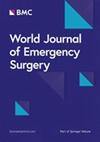鱼骨迁移:并发症,诊断挑战和治疗策略
IF 5.8
1区 医学
Q1 EMERGENCY MEDICINE
引用次数: 0
摘要
鱼骨嵌塞在咽是一种常见的耳鼻喉急症。但是,如果鱼骨穿过咽壁或胃肠壁,迁移到颈部组织或器官,进入肺、纵隔、心脏、肝脏、胆道、脾脏、胰腺等结构,或损害胸腔、腹腔的主要血管,则可导致严重的并发症。该病罕见且危险,可导致颈部脓肿、甲状腺脓肿、颈血管血栓形成或空气栓塞、食管穿孔、纵隔大血管破裂、纵隔炎、主动脉-食管瘘、肺脓肿、脊髓损伤、败血症、脾脓肿、肝脓肿、肛瘘等一系列严重并发症,甚至可能误诊为肿瘤。本文综合了有关鱼骨易位并发症的证据,以(1)确定高危临床表现,(2)指导特定部位的影像学选择,(3)为多学科管理策略提供信息。使用关键词“鱼骨”系统检索1972年至2024年PubMed、CNKI和Embase数据库中的文章。审查所有的原始文章,并在适当的地方将它们包括在本审查中。本文综合了来自病例报告和观察性研究的证据,以探讨罕见部位鱼骨移位的并发症和处理。鉴于异质性病例报告占主导地位,采用meta分析的正式系统评价是不可行的;然而,我们采用了系统的搜索策略来最小化选择偏差。为了避免严重的并发症,提供有关治疗鱼骨嵌塞的综合信息至关重要。当喉镜检查无法去除鱼骨时,需要及时果断的手术干预以取出异物。本文章由计算机程序翻译,如有差异,请以英文原文为准。
Fish bone migration: complications, diagnostic challenges, and treatment strategies
Fish bone impaction in the pharynx is a common otolaryngological emergency. However, if the fish bone perforates the pharyngeal wall or the gastrointestinal wall and migrates to the neck tissues or organs, entering the lungs, mediastinum, heart, liver, biliary tract, spleen, pancreas, or other structures, or damages major blood vessels in the thoracic or abdominal cavities, it can lead to severe complications. This condition is rare and dangerous, potentially resulting in a series of serious complications, including neck abscess, thyroid abscess, thrombosis or air embolism of the cervical vessels, esophageal perforation, rupture of major mediastinal vessels, mediastinitis, aorto-esophageal fistula, lung abscess, spinal injury, sepsis, splenic abscess, hepatic abscess, anal fistula, and it may even be misdiagnosed as a tumor. This narrative review synthesizes evidence on fish bone translocation complications to (1) identify high-risk clinical presentations, (2) guide site-specific imaging selection, and (3) inform multidisciplinary management strategies. Use the keyword “fishbone” to systematically search articles from PubMed、CNKI and Embase databases from 1972 to 2024. Review all original articles and include them in this review where appropriate. This narrative review synthesizes evidence from case reports and observational studies to explore complications and management of fish bone translocation in uncommon sites. Given the predominance of heterogeneous case reports, a formal systematic review with meta-analysis was not feasible; however, we employed systematic search strategies to minimize selection bias. To avoid severe complications, it is crucial to provide comprehensive information on the management of fish bone impaction. When fish bone removal cannot be achieved using laryngoscopy, prompt and decisive surgical intervention is required to extract the foreign body.
求助全文
通过发布文献求助,成功后即可免费获取论文全文。
去求助
来源期刊

World Journal of Emergency Surgery
EMERGENCY MEDICINE-SURGERY
CiteScore
14.50
自引率
5.00%
发文量
60
审稿时长
10 weeks
期刊介绍:
The World Journal of Emergency Surgery is an open access, peer-reviewed journal covering all facets of clinical and basic research in traumatic and non-traumatic emergency surgery and related fields. Topics include emergency surgery, acute care surgery, trauma surgery, intensive care, trauma management, and resuscitation, among others.
 求助内容:
求助内容: 应助结果提醒方式:
应助结果提醒方式:


